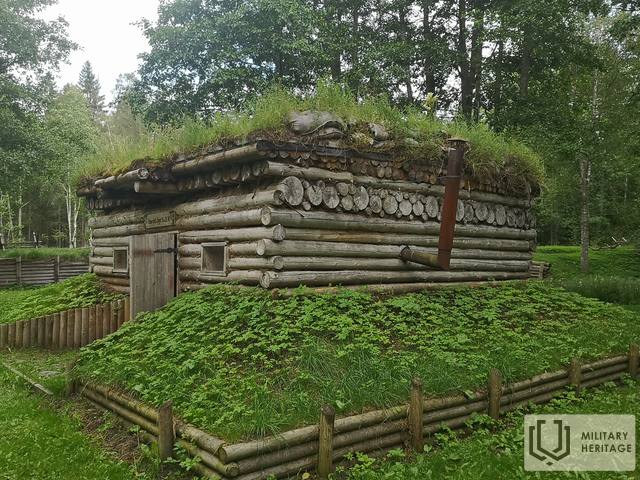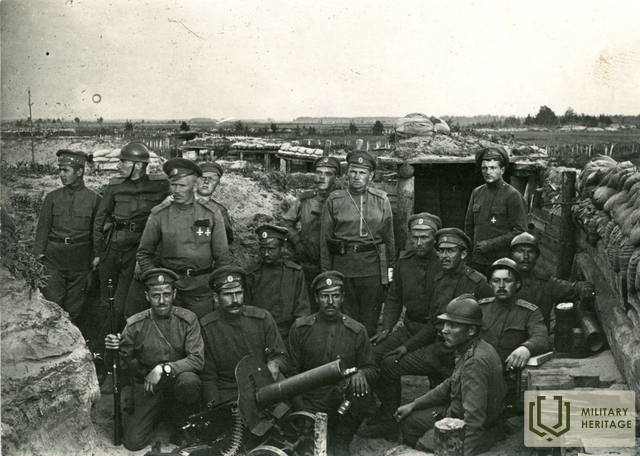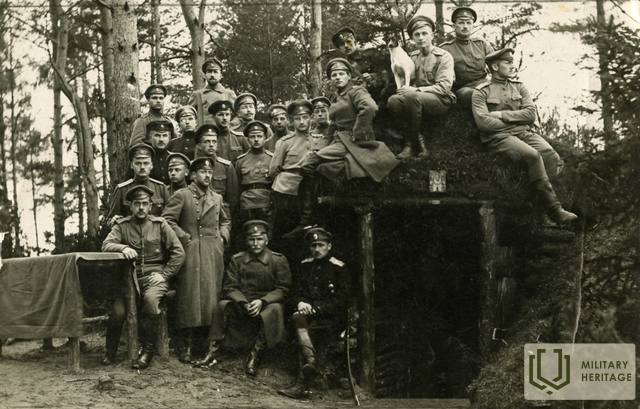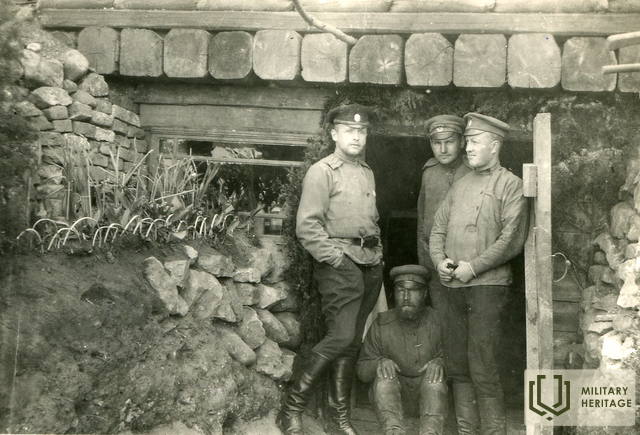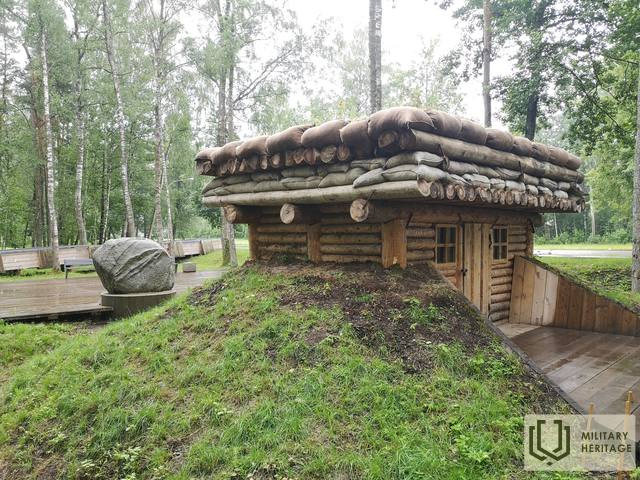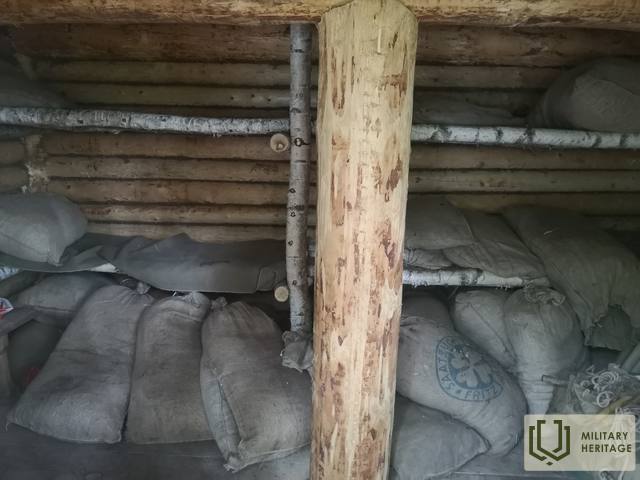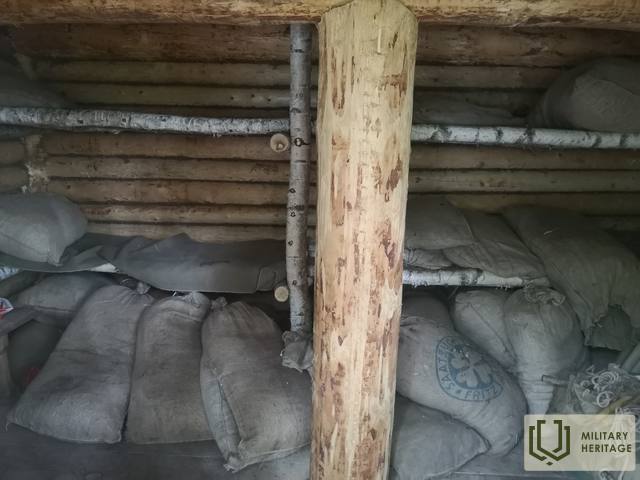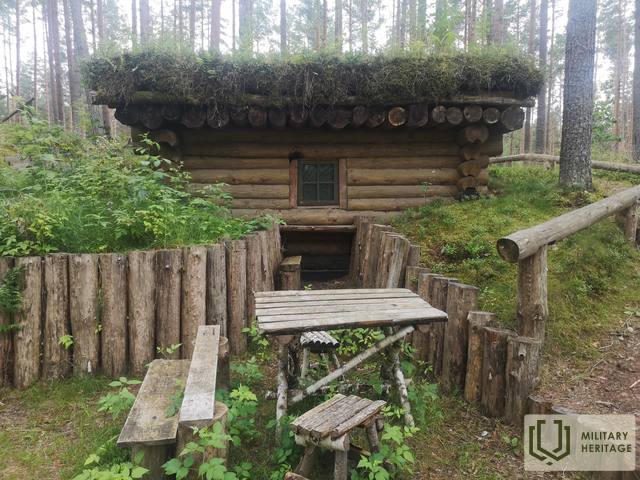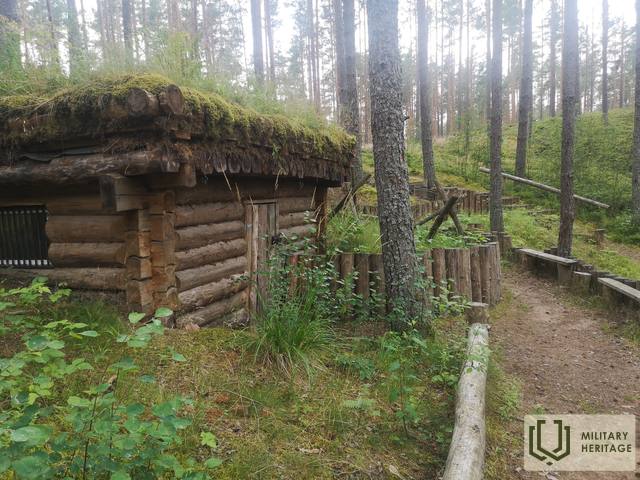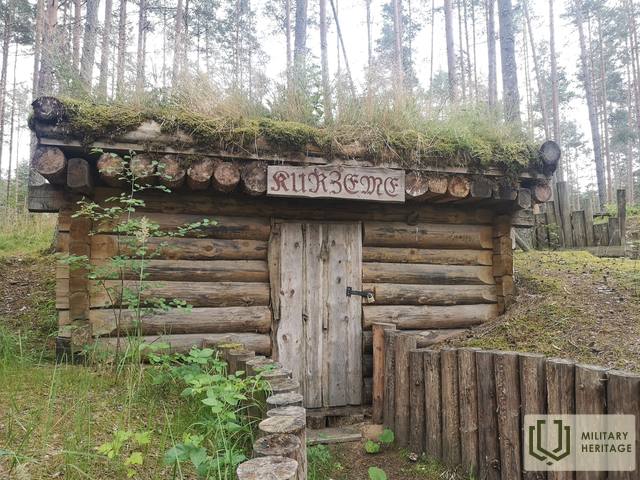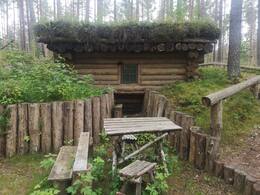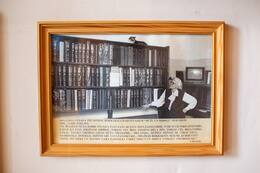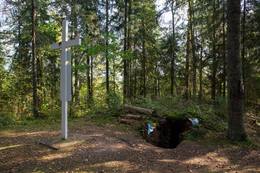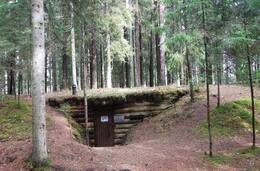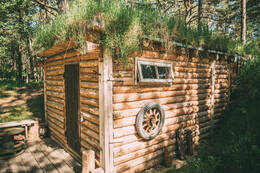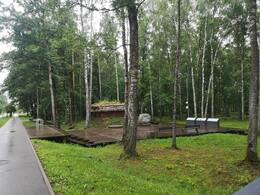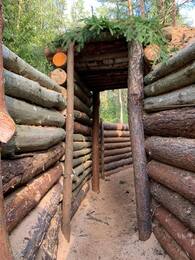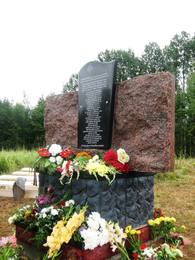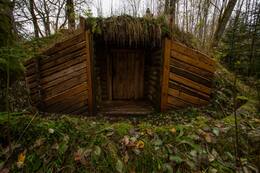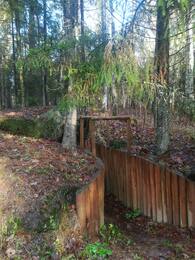Dugout
I WW1, I Nepriklausomybės karai, II WW2, III Nacionaliniai partizanai
Apvalus ar stačiakampis į žemę įkastas būstas su stogu iš rąstų, rąstų ir kt. ir tt dangtis, padengtas žeme. Iš pradžių sąlygos šiuose iškasuose buvo labai kuklios: keli mediniai gultai, stalas, viena krosnelė Šiandien kariai gyvena kur kas geresnėmis sąlygomis, todėl galime tik grožėtis to meto kariais, kurie gyveno tokiomis sąlygomis, o nuolat buvo karo zonoje, keletą metų. Povandenių dydžiai buvo įvairūs, juose galėjo prisiglausti nuo kelių iki net 10 žmonių. Kariuomenės žinynai rekomendavo, kad iškasai būtų 0,6–1,4 m pločio ir bent 25 cm grunto, tačiau karui tęsiantis iškasai išsiplėtė, tapo didesni, juose tilpo visas batalionas. Didesni iškasai buvo statomi štabo reikmėms ir dažniausiai būdavo toliau nuo fronto linijos. Prieglaudų kūrimo principus lėmė reljefas, turimos medžiagos, karių įgūdžiai. Kastuvų dydis ir saugumo laipsnis priklausė nuo jų artumo prie pirmosios tranšėjų linijos. Yra žinoma, kad kai kurių pastogių stogo konstrukcijoje buvo daugiau nei 10 sluoksnių rąstų, o jų sutvirtinimui naudotos betoninės plokštės ir geležiniai bėgiai, taip pat atlaikytos statybinės medžiagos.
Tiek eiliniai, tiek pareigūnai naudojo iškasus kaip prieglobstį ir poilsio vietą. Buvo tikima, kad iškasai gali apsaugoti karius tiek nuo nepalankių oro sąlygų, tiek nuo artilerijos ugnies, tačiau atsitiko taip, kad dėl tikslaus šūvio iškasoje žuvo visi jo gyventojai. Partizanų būriai taip pat aktyviai formavo požeminius apkasus. Iš šaulių prisiminimų galime susidaryti supratimą apie kasdienybę ir nakvynes rūsiuose. Vakarą prieš Martos, arba Ķekavos, mūšį savo atsiminimuose aprašė 1-ojo Daugavgrivos latvių šaulių bataliono šaulys Fricis Riekstiņš: «Kovo 8-osios naktį (kovo 21 d. pagal naująjį stilių) praleidome su kitais savo bendražygiais didesniame rūsyje, kur kūrenome laužą. Duobėje nebuvo skylių dūmams, todėl teko atsigulti ir nuryti aitrų dūmą, nuo kurio prasidėjo stiprus kosulys ir gilus užkimimas gerklėje. Man labiau patiko šaltis, o ne dūmai, bet ką galėčiau padaryti kitiems nariams karštis ir dūmai labiau nei šaltis?
Daugiau informacijos šaltinių
https://www.naa.mil.lv/en/node/222
https://tezaurs.lv/zemn%C4%ABca:1
Susijusi laiko juosta
Susijusios vietos
Latvijos šaulių pozicijos ir apkasai Tyreliuose
Latvijos šaulių apkasai ir apkasai Tyreliuose yra Babytės valsčiuje, Mārupe savivaldybėje, netoli Antinių latvių šaulių kapinių ir buvusio vaistų sandėlio. Pirmojo pasaulinio karo metu tai buvo Rusijos imperijos armijos Latvijos šaulių gynybinė pozicija. Smėlėtose kalvose buvo įrengtas apkasų ir paviršinių apkasų kompleksas. Apkasinė arba pozicinė kova – tai geriausias būdas tiksliai apibūdinti Pirmąjį pasaulinį karą ir pabrėžti įtvirtinimų svarbą. Jie buvo pagrįsti karo inžinierių tyrimais, pritaikyti prie aplinkos ir naujų ginklų kūrimo. Kareivio kasdienybė – tai nuolatinis gynybinių įtvirtinimų tobulinimas. Kartais kareiviai apkasams duodavo pavadinimus, kurie primindavo jų namus ir padėdavo pamiršti karo realybę. Apkasų linijos buvo sudėtingos gynybos sistemos, kurias priešui buvo sunku perimti. Tobulėjant ginklams, ši gynyba tapo dar sudėtingesnė. Apkasų stogai buvo sutvirtinami, kad atlaikytų artilerijos sviedinius. Apkasai buvo kasami keičiant schemas ir kryptis, kad sprogimai padarytų kuo mažiau žalos. Judėjimo praėjimuose buvo kišenės, kurios buvo naudojamos kaip trumpalaikės slėptuvės artilerijos ugnies metu, nes jos saugojo kareivius nuo skeveldrų ir nuolaužų. Šiandien dalis įtvirtinimų yra atkurta, ir galite aplankyti 3 restauruotus apkasus ir 100 m ilgio apkasų atkarpą.
Museum of Melānija Vanaga and Siberian dugout
The Melānija Vanaga Museum is located in the Amata village school in Cēsis municipality. The museum showcases materials about the life, literary activity, family and destiny of writer and cultural historian Melānija Vanaga: video content about Siberia and the deported Latvians living there and a Siberian dugout taking its visitors on a trip to the writer’s place of deportation in Tyukhtetsky district, Krasnoyarsk region. The appearance and layout of the dugout form a realistic idea of life away from home. The dugout features unique historical objects brought there from the Tyukhtet Museum: a birch-bark dish known as ‘tuyesok’, a clay mug known as ‘krynka’ and a kerosene lamp. The museum features video interviews with politically repressed people from the municipality and 18 characters from Melānija Vanaga’s book Suddenly, a Criminal: Sixteen Years in Siberia. The museum’s virtual exhibition ‘BE YOURSELF!’ (http://esipats.lv) shows the experiences of five deported children and their parents who were wrongly accused by the Soviet authorities of ‘betrayal of the motherland’.
Vesetos partizanų žeminė ir atminimo vieta „Baltasis kryžius“ (Baltais krusts)
Vesetos partizanų žeminė ir atminimo vieta „Baltasis kryžius“ yra Vesetos užliejamos pelkės teritorijoje. Po Antrojo pasaulinio karo Vietalvoje veikė vadinamoji Parupo partizanų grupė. Jai vadovavo Richardas Parupas (1914–1946), buvęs vokiečių kariuomenės 15-osios latvių divizijos seržantas. Karo metais jis dalyvavo nacionalinių partizanų veikloje Jėka bpilio ir Maduonos apylinkėse. Per neilgą gyvavimo laikotarpį Parupo grupė surengė daugiau kaip dvidešimt ginkluotų susirė mimų su tuometės Vidaus reikalų ministerijos daliniais. Čekistų pulkininko Kotovo ataskaitoje savo vadovybei Rygoje teigiama, kad dėl šios grupės veiklos sovietinės valdžios įsitvir tinimas Jekabpilio ir Maduonos rajonuose buvo paralyžiuotas. Parupo vadovaujami nacionaliniai partizanai surado ir sunaikino kelis tremiamųjų sąrašus, taip išgelbėdami daugelio žmonių gy vybes. Kadangi atviroje kovoje nacionalinių partizanų būrio su naikinti nepavyko, Saugumo komitetas į jį infiltravo keturis čekistų specialiosios grupės narius. 1946 m. liepos 2 d. naktį šie agentai nušovė dešimt būrio partizanų, tarp jų ir Richardą Parupą. Nužudytųjų palaidojimo vieta nežinoma, tačiau Rygos brolių ka pinėse įrengta jiems skirta atminimo lenta. Prie Vesetos partizanų žeminės stovi paminklas „Baltasis kryžius“ – 3 m aukščio baltas kryžius su lenta, kurioje iškalti 1946 m. liepos 2 d. žuvusių partizanų vardai ir pavardės.
Rubenio bataliono bunkeris ir mūšio laukai
Restauruotas Rubenio bataliono 2-osios kuopos žeminė yra miške prie Ilziki ežero Usmos valsčiuje. Žeminę galima apžiūrėti iš išorės nemokamai bet kuriuo metu. Tačiau ekskursijas žeminės viduje būtina užsisakyti iš anksto.
Leitenanto Roberto Rubenio batalionas buvo generolo Jānio Kurelio suformuoto karinio dalinio dalis ir žinomas dėl to, kad nepasidavė vokiečių kariuomenei ir demonstravo didelį pasipriešinimą. 1944 m. lapkričio 14–gruodžio 9 d. Ugalės, Usmos, Rendos ir Zlėkų valsčiuose vyko įnirtingi mūšiai tarp 16-osios Vokietijos armijos, SD ir SS dalinių, vadovaujamų policijos generolo Friedricho Jeckelio, ir Kureliečių dalinio bataliono, vadovaujamo leitenanto Roberto Rubenio. Rubenio vadovaujami vyrai buvo gerai ginkluoti ir organizuoti, nesiejo savęs su jokia iš dviejų priešiškų okupacinių jėgų. Jų veiksmai laikomi plačiausiais ir ilgiausiais Latvijos nacionalinio pasipriešinimo judėjimo istorijoje. Mūšiuose prie Rendos ir Zlėkų žuvo apie 250 vokiečių kareivių, o Rubenio vyrai patyrė tik 50 aukų. Tų dienų įvykius simbolizuoja miške atkurta žeminė (velėna dengta, žemėje iškasta rąstinė trobelė), kurioje kadaise buvo apsistoję Rubenio bataliono vyrai.
Atstatyti vokiečių armijos apkasai Melnsils stovyklavietėje
Kempingas „Melnsils“ yra įsikūręs prie jūros, 10 km nuo Kolkos. Čia pastatyti vokiečių armijos tipo apkasai, kuriuose galima apsistoti nakčiai. Tai užuomina į šio regiono istoriją, kai Antrojo pasaulinio karo metu vokiečių armija čia turėjo pasienio apsaugos postą ir stovyklavietę, o kareiviai statėsi apkasus iš netoliese rastų medžiagų. Pakrantės kopose vis dar galima rasti apkasų.
„Bunkeris Nr. 13“ yra didžiausias iš dviejų bunkerių, kuriame yra trys dviaukštės lovos. „Mažasis bunkeris“ yra mažesnis ir jame yra dvi dviaukštės lovos. Kempingas „Melnsils“ – puikus pasirinkimas aktyviam poilsiui ir sporto renginiams iki 300 žmonių. Jis įsikūręs netoli Sliterės nacionalinio parko, pakrantės skardžių ir miško pėsčiųjų takų. Rajone yra pažymėti dviračių takai, vingiuojantys per natūralią aplinką. Prie jūros yra įrengtos vietos palapinėms ir laužavietėms, taip pat statinės tipo svečių nameliai dviems ar keturiems asmenims. Taip pat yra pirtis su įvairių rūšių vantomis.
Pirmojo pasaulinio karo istorinių žvalgybų maršrutas ir apkasas
Įsikūręs Olainėje, netoli Olainės istorijos ir meno muziejaus.
Istorinis maršrutas buvo sukurtas 2018 m. Pirmojo pasaulinio karo metu Rusijos armijos įtvirtinimų, kurie buvo vietovės gynybos sistemos dalis, vietoje. Vokietijos ir Rusijos armijų mūšiai Olainės apylinkėse patraukia dėmesį dėl kelių priežasčių. Pelkėta vietovė neleido kariaujančioms šalims greitai pasiekti sėkmės ir reikalavo iš kareivių įvairiapusiškų įgūdžių, veikiant nepalankiomis sąlygomis. Karo metu svarbų vaidmenį atliko tiksli reljefo analizė, žvalgyba, įtvirtinimai ar inžineriniai statiniai.
Šiandien edukacinis maršrutas yra laisvai prieinamas ir suteikia apytikslį vaizdą apie karių gyvenimo sąlygas. Restauruoti pastatai yra uždaryti, tačiau juos galima apžiūrėti iš anksto susisiekus su Olaine'ės istorijos ir meno muziejaus specialistais.
Mirties sala
Salų grupė yra Dauguvoje, Rygos HE rezervuaro pietinėje pusėje, netoli Daugmalės. Mirties sala yra vienas baisiausių ir legendomis apipintų Pirmojo pasaulinio karo mūšio laukų. Kai 1915 m. Rusijos armija pasitraukė iš Kuržemės ir Žiemgalos, kai kurie daliniai liko kairiajame Dauguvos krante, kur užėmė pozicijas kovai su Vokietijos armija. Upės krantus jungė tiltas. Čia įvyko vienas didžiausių cheminio ginklo panaudojimo atvejų Latvijos teritorijoje. Latvijos kareiviai šią vietą vadino „Mirties sala“, o kitų tautybių kareiviai – „Pragaru“. Mirties salos vieta turėjo strateginę ir simbolinę reikšmę. Latvijos kareiviams ji buvo Vokietijos okupuotos Kuržemės dalis. Kovos vyko Dauguvos pakrantėse netoli Ikškilės, kurios tam tikra prasme buvo susijusios su protėvių kovomis kryžiaus žygių metu. Šiandien į šią vietą galima patekti laivu. Galima pamatyti neužtvindytą Rygos HE rezervuaro teritoriją. Vis dar išlikęs E. Laubės suprojektuotas paminklas. Kai kuriose vietose rekonstruoti gynybinės pozicijos elementai. Dauguvos krante, netoli Ikškilės Kābelių kalvos, yra informacinis stendas. Mirties sala tapo salų grupe, kai buvo baigta statyti Rygos HE rezervuaras.
Monument to members of the resistance movement in Stompakis
It is located 15 km from Balvi in the direction of Viļakas, on the right side of the road.
A memorial is visible.
The memorial to the members of the resistance movement, dedicated to the memory of the national partisans of Pēteras Supes who fell in the battles of March 2 and 3, 1945, on the side of the Balva - Viļaka highway opposite the Stompaki swamp, was opened on August 11, 2011, on the day of remembrance of Latvian freedom fighters. At the end of July, a capsule with a message for future generations was embedded in the base of the monument. A document with the names of 28 national partisans who fell in the battles of March 2 and 3, 1945 is placed in the capsule.
"In February 1945, Latvia's largest national partisan camp was established on the islands of the Stompaku swamp, which the people began to call the islands of the Stompaku swamp, 2 km from the Balvu - Viļaka highway, where 360 people lived in 22 dugouts. Among them, some legionnaires who, for the legion division retreating, they had stayed at their father's house with all their weapons. In order to destroy the partisans, on March 2, 1945, the soldiers of two battalions of Czech troops attacked the dugouts together with destroyers, which also had four mortars in their armament. The battles took place all day, the partisans resisted stubbornly, and the attackers suffered suffered great losses, so that they could not capture the camp and destroy the partisans. 28 inhabitants of the Stompaku swamp had also fallen or died after being seriously injured in the battle. The next night, the partisans broke the siege of the camp with a battle and left undefeated" - this is what a member of the national resistance movement of the award department writes about the Stompaku battle chairman of the case commission, Zigfrīds Berķis.
Battles and memorials of national and Soviet partisans in the Griva forest massif
It is located in the Griva forest massif.
Six objects related to the places of national and Soviet partisan battles are under consideration.
In the forest massif of Griva, there are not only the headquarters of the "Purvsaliņi" national partisans, the White Cross in the bunker of the national partisans and the cross to the commander of the resistance movement Andrejas Roskoš, but also the grave of the Soviet partisan brigade commander Artūrs Balož, a monument on the so-called Maiden Hill, where a Soviet partisan died in 1944 the group of young partisans of the brigade, as well as a monument to the Soviet partisans with a five-pointed star and the engraved words "Let's cover ourselves with needles".
It is also possible to view the objects by going for a ride with a two-wheeler on bicycle route no. 785 - "Rhymes of history in the forests of Griva" (route length 34 km, gravel and forest roads). Map for download.
Memorial place for the commander of the national partisan group Andrejas Roskoš (GPS 56.87399, 27.43524)
In the autumn of 1997, the White Cross was discovered in Lielgrivas forest for the commander of the national partisan group Andrejas Roskoš.
Monument to Artūrs Balodis (GPS 56.872926, 27.478121)
Artūrs Balodis was a Soviet partisan, the commander of special tasks of sub-unit A, which was stationed in the Griva forest massif. Fell in the extensive "combing" carried out by the occupiers of Nazi Germany. The comrades carved the letters AB in the birch tree at the place where he died, so that it would not be forgotten. After the war, local researchers found the marked birch and installed a commemorative plaque in its place.
For all those who fell in the forests of Griva (GPS 56.863280, 27.47975)
This commemorative stone in the Griva forest massif has been installed by VAS "Latvijas valsts meži" in honor of the partisans who fought for their homeland. Next to the memorial stone, there is a map-scheme with indications of the partisans' headquarters and places of interest. There is also a rest area. Nearby is the settlement of the national partisans, 1945-1947.
National partisans settlement (GPS 56.863456, 27.481148)
In this place there were settlements of national partisans who fought against the Soviet occupation. The places of individual bunkers have been preserved, by their visual appearance you can judge how big and what shape the dugouts were. National partisans, resisting the Soviet power, operated in the forests of Griva for several years after the end of the Second World War.
Griva forest memorial ensemble, dugout (GPS 56.860665, 27.490439)
It was built in memory of the Soviet partisans who lived in the forests of Griva. Guerrillas blew up the local railway network and trains to disrupt the supply of ammunition, food, etc. to the Nazi German army. Memorial stones have been placed in places where trenches were dug during the war. In the restored dugout you can feel the atmosphere of wartime.
Girls' hill (GPS 56.858187, 27.521526)
In June 1944, the occupiers of Nazi Germany carried out an extensive "combing" of the Griva forests with the intention of destroying the partisans. The soldiers on the hill of Numerne besieged the economic company, which consisted mostly of young girls, and all of them were shot. Since these tragic events, Numerne hill was renamed Meitenu hill by local residents. A memorial stone has been erected at this location.
Memorial site of national partisans in Sērmūkši
Sērmūkši is home to one of more than a hundred memorials to partisan battles in Latvia. There are more than six hundred partisan battle sites in Latvia. A Latvian national partisan dugout has been built based on historical evidence, and visitors can spend the night in near-authentic conditions with plank beds, lighting provided by kerosene lamps and a heating device similar to the ones used by partisans. Visits must be booked in advance. The fateful moment for the Sērmūkši National Partisan Group came on 29 November 1946 with the deaths of four fighters from the group: Jānis Zīrāks, Reinholds Pētersons, Jānis Pīlands and Anna Zariņa. Alfrēds Suipe survived, endured deportation, returned to Latvia and saw the restoration of a free state. He initiated the idea to establish a memorial site for his fallen companions in Sērmūkši.
Bunker of the Red Army and caponiers in Aizvīkai Park
Aizvīkai Manor Park is located in Aizvīki, Gramzda Parish, just a few kilometers from the Lithuanian border.
The places of bunkers and trenches from the 2nd World War are still clearly visible in Aivvikai Park. The Red Army bunker has been restored in the park.
One of the types of weapons during World War II was the "Katyusha" rocket launch system. Several such Rocket Launching Systems were located in Aizvīki Park, even now these places (caponieri) are clearly visible in nature.
In order to get to know the cultural and historical heritage of Aizvīkai Manor Park more fully, we recommend using the services of a guide.
Evidence of the 2nd World War in Aizvikai Park
Aizvīkai Manor Park is located in Aizvīki, Gramzda Parish, just a few kilometers from the Lithuanian border.
The places of bunkers and trenches from the 2nd World War are still clearly visible in Aivvikai Park. One of the types of weapons was the Katyusha rocket launch system. Several such Rocket Launching Systems were located in Aizvīki Park, even after the end of the 2nd World War, and these places (caponieri) are clearly visible in nature.
This unique forest park, shrouded in secrets and legends, was created at the end of the 19th century as the Aizvīkai Manor Park, when the baron of the manor von Korff covered the nearby hilly land with a pine and spruce forest. Later, walking paths were laid on the 40 ha area, trees of other species were also planted and a pheasant garden was established.
In addition to the picturesque forest landscapes, there are also fairy-tale and fairy-tale figures made of wood, as well as stone sculptures, which tell travelers about events from the history of Aizvīkai and mark the cultural and historical places in the park. A Green Class has also been created in the park.
In order to get to know the cultural and historical heritage of Aizvīkai Manor Park more fully, we recommend using the services of a guide.
Susijusi istorija
Apie Latvijos lankininkus Olaines apylinkėse
Prisiminimuose atsispindi Latvijos lankininkų kasdienybė Olaine apylinkėse. Aprašomos ne tik gyvenimo sąlygos, bet ir įprasta užduotis – priešininko pozicijų žvalgyba.
Gynybinių pozicijų formavimas.
Aprašyme apskritai nagrinėjama mūšio lauko įtvirtinimo problema. Jis sukurtas remiantis I pasaulinio karo patirtimi ir situacija, kai būtina organizuoti didelius įtvirtinimų kūrimo darbus.
Sovietų armijos neįgyvendinti planai Kuržemės pakrantėje Melnsilyje ir Gipkoje
Baigiantis Antrajam pasauliniam karui Melnsilyje buvo dislokuota vokiečių karinio jūrų laivyno 532-osios artilerijos divizijos 6-oji baterija, tačiau Raudonoji armija šiai vietovei turėjo savų planų, kurie taip ir nebuvo įgyvendinti iki Vokietijos kariuomenės kapituliacijos 1945 m. gegužę.




